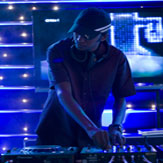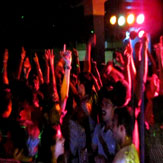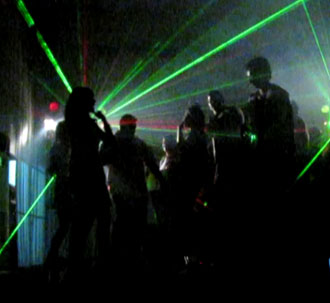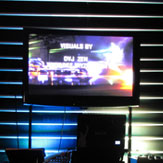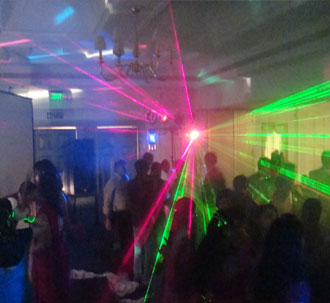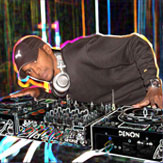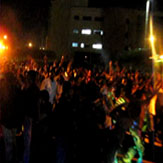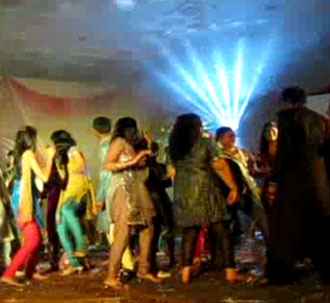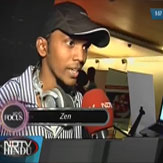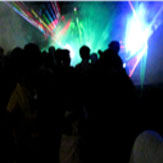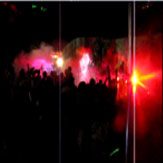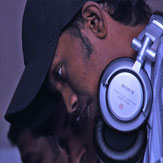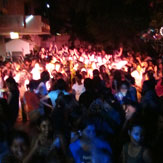|
Learn the Language of DJ's The most complete dictionary of the terms used in DJing lives are here. Basic electronics, equipment, track structure, and the slang of DJ culture are covered. If you think a word or phrase may be missing from this list, or incorrectly defined, please email me at djzenchennai@gmail.com Help me make this a great resource for everyone!
|
# - A - B - C - D - E - F - G - H - I - J - K - L - M - N - O - P - Q - R - S - T - U - V - W - X - Y - Z |
# | | 1200 | 1200 is the model of Technics record player that is most popular in the world for DJing. Often the turnatbles are simply called "1200s." | | 2 Step | This sub genre of breakbeats is typified by R'n'B vocals and a prominent snare drum. | | 2 x 4 | When two DJs play on four turntables connected by three mixers the setup is called a 2 x 4 ("two by four"). In order to create a 2 x 4 setup, one pair of decks and a mixer are placed on each side of a central mixer. The left and right mixers feed into the central one, which has it's crossfader set in the middle to allow each channel equal output. The left channel represents the left hand DJ, the right channel controls the input of the right hand DJ. The central mixer controls the master volume.Any multiple of turntables and mixers can be combined to make, for example, a 3 x 6 (three DJs, 6 decks), a 4 x 8 and so on. Playing on these setups requires that the DJs communicate well and know each other's styles and records thoroughly. Generally in larger setups the DJs will be spinning over each other, layering sounds to create an almost orchestral arrangement of beats and melodies. The DJs also often take turns spinning records using this setup, playing one, two or more records each before allowing the other to play the same number. This is known as tag teaming, or tagging. | | 303 | The TB303 (Transistor Bass) was introduced in the early 1980s together with the TR606 Drumatix (Transistor Rythm) by Roland. It was invented by Tadao Kikumoto. The 303 sounds didn't come anywhere near a real bass or drum set, and the musicians didn't want to go through the time-consuming task of programming the machines. Since nobody wanted the TB303 anymore, Roland stopped producing them 18 months after releasing it. At that time they'd produced about 20.000 copies alltogether. It was not until 1987 when a DJ (rumors has it that it was DJ Pierre) came up with the idea to turn the knobs while playing the TB303 that acid house was born. After that the machine suddently became more and more wanted and soaked for. Today's acid music is very different from the acid house of the 80's/early 90's. Now acid music is typically produced using the TB303 and a TR909. The TR909 drum machine produces a much more hard, much more dancable beat. The bassdrum really kicks and it has got a very famous clap! Read more about the 303 at http://www.tb-303.org/info/history.asp | | 33 | A record that plays at 33 and one third rpm. | | 4/4 | A time signature in which there are 4 quarter note beats per bar. One-two-three-four, one-two-three-four, one-two-three-four, etc. Most electronic dance music is 4/4. | | 45 | A record that plays at 45 rpm. | | 45 RPM adapter | See: RPM adapter | | 606 | The TR-606 is a drum machine which Roland manufactured from 1981 to 1983. It was designed to be used in tandem with the TB-303 Bassline so as to be able to reproduce a drummer and bass player for guitarists without backing bands. It sold a fair few units (around 30000 apparently), but wasn't very popular amongst guitarists because the drum sounds weren't too realistic. All the sounds in the 606 are generated with analog technology - noise sources and voltage controlled filters. The kind of sounds created by this technology aren't realistic, but kind of electro/retro sounding. When house and techno arrived in the mid-80s, musicians were looking for cheap gear which could make decent sounds, and the 606 was a perfect choice. Because guitarists didn't like the non-realistic sounds, they were only too happy to get rid of their 606s for a couple of dollars to kids who could really use them.
Now the 606 has become a basic tool for many electronic musicians, including Autechre, Aphex Twin, Plastikman, and Nine Inch Nails. Its excellent programming interface, bouncy sounds and small size make it an ideal machine for "just banging out patterns". What many artists don't realize though is the power this machine can have when modified! Individual outputs for each drumsound increase the usability infinitely, and once you start modifying the sounds themselves, you can get a very capable drum machine indeed. Tip of the cap to http://machines.hyperreal.org/manufacturers/Roland/TR-606/info/drumantix/ for this information. | | 808 | The Roland TR 808 is a classic analog drum machine and used in most R&B and Hip Hop records but also in Dance and Techno music. It was introduced in 1980. The "booming" bass kicks, "crispy" snares and that typical cowbell made the 808 famous and one of the most important drum machines in the history of music. The SOS Band, Change, Surface, Loose Ends, 52nd Street, etc. used it a lot. | A | | Acapella | A track containing only vocals - with no drums, melody or other accompaniment. | | Acid | Prefix to a number of genre names (such as acid house, acid trance etc) in which the use of the infamous Roland 303 drum machine creates a distinctive sound. | | Adapter | Any piece of hardware that allows two disparate pieces of equipment to work together. The RPM adapter is an example. | | ADAT | The ADAT (a registered trademark of Alesis) is an eight-track digital tape recorder that caught the recording industry by storm when it was first released in the early 1990s. Today, with over 100,000 ADATs in use in recording facilities around the world, it is the most widely used professional digital recording system. The ADAT was the first product in the category now known as modular digital multitracks (MDMs). The ADAT system allows up to 16 ADAT units to be used in synchronization, enabling the user to build a very cost-effective multi-track recording environment. The transportability and modularity of the system makes it ideal for mobile recording and wherever space is limited. Digital transfer between ADATs in a system uses a optical fiber digital communication standard pioneered by Alesis which has become known as Lightpipe. The Lightpipe digital interface has been adopted by other manufacturers as a means of transferring digital data from other types of audio devices, such as mixers, synthesizers, and effect processors. The ADAT uses the S-VHS 1/2 inch tape format. This tape is similar in design to the tape used in consumer VCRs. | | A/D Converter | An A/D (Analog to Digital) converter is an electronic device who's function is to convert analog voltages into a digital representation of electrical ones and zeros which can be stored, manipulated, and later retrieved or converted back to analog. | | Agent | Also: Booking agent. A person who deals with the logistics of your DJ bookings, such as sending out demos and press packs, negotiating fees and hotels rooms and arranging flights. An agent usually takes about 15% of your fee in payment for these services. | | Alesis™ | Alesis invented the ADAT, and also makes power amps, drum machines etc. | | Ambient | Ambient, or atmospheric electronica is background music: it was meant to be heard rather than listened to. The term is now extended to the more atmospheric techno music from 0 to 70 bpm. Illbient is a sub genre of ambient music invented by DJ Spooky in which the feel of the track is more disturbing then relaxing. Nu jazz is another sub genre of ambient. Ambient also refers to the beginning and end sections of a track where there are often no beats, or audible percussive rhythm. | | Amplifier, Amp | This device amplifies (makes larger or increases) the signal from the mixer so that a pair (or pairs) of speakers can be powered. Some speakers are "self-powered," with built in amplifiers, but the majority require a separate amp to operate. | | Amtrak | A really bad trainwreck. After the American rail company, AMTRAK. | | Analog | Of, relating to, or being a device in which data are represented by continuously variable, measurable, physical quantities, such as length, width, voltage, or pressure. The opposite of digital. | | Anthem | A track with a serious tone, having a dramatic crescendo, or build. Also a very well-known track that has come to typify a certain genre due to its popularity. Originally referred to choral arrangements,and other religious songs of praise. | | Anti-skating | A feature found on professional turntables that prevents the needle from skipping across the record. Normally used in conjunction with the counter weight, the value of the anti-skate represents the force of the tonearm trying to skate away from the center of the record. | | Attenuation | The reduction in sound level caused by earplugs, and measured in an NRR rating of decibels (dB). You should use earplugs that attenuate 20 dB of sound to protect your hearing in situations where you have to have difficulty hearing someone speak within 3 feet of you. | | Aux or Line in | Abbreviation for auxiliary, meaning secondary or supplementary. In the case of DJ equipment such as a mixer or amplifier, the aux socket allows a secondary piece of equipment to be plugged in, a CD player for example. If you would like to record yourself mixing, your mixer should connect to the AUX socket on your hi-fi or stereo. | B | | Back cue, to | See cue. | | Backspin | See spinback. | | Bar | A collection of beats. Commonly there are four beats per bar. | | Battle | A hip hop or drum and bass DJing competition in which DJs compete against each other in short sets showcasing their skills and track selection. | | Battle style | A way of orienting the turntables on their table so that the tonearm sides of the decks are furthest away from the DJ, as opposed to the ususal layout where the tonearm is to the right of the DJ. This method prevents the DJ's arms from brushing the tonarm and disrupting their set in the heat of a battle. | | Beat | A unit of rhythmical noise in music, it can be made up of several notes or fractions of a note. The most common beats come four per bar (a 4/4 time signature). | | Beat Counter | An electronic device that counts the beats per minute (bpm) of a track. Usually this is done by the user tapping a special pad with their finger in time to the music. The beat counter then works out how many beats per minute this would equate to. Very often beat counters and metronomes are comined in once device. | | Beatmatch, to | The art of synchronizing and blending two separate tracks which to start off with had totally different speeds or tempos. | | Beat juggle, to | This technique is performed by using two records and manipulating the arrangement of the elements (drum sounds, headnotes, vocals etc.) from both to create a new rhythmical composition. For example, in a very simple beat juggle one or more bars of record A are played, then the DJ quickly flips the crossfader to the beatmatched record B for one or more bars, then back to A and so on. | | Bias | When the crossfader or cue mix is output at a higher volume on one channel it is said to be biased to that channel. e.g. If the crossfader is more to the right hand side. It is more biased to the right channel than it is to the left. | | Binary mixer | | | Belt drive | One of the major differences between turntables is whether they are belt or direct drive. Belt drive turntables have their platter driven by a thick 'rubber band' compared to the DJ's preferred turntable, the direct drive, which is driven by a motor directly, giving increased torque for a faster pick up time. Belt drive turntables are not used in professional DJing due to their slow pick up time but audiophiles appreciate high end versions for their long belts which leaves the motor far away from the needle. This improves audio quality by significantly reducing motor noise picked up by the needle. | | Black Lacquer | Black Lacquer is the standard record pressing industry technology. The process involves cutting a master plate (a mirror of the stampers), after which a stamper (a metallic plate that stamps the record) is made. This stamper is then punched into the hot vinyl to create the record. The advantages of this medium are obvious when creating vinyl for dance music. The pressing can be louder, and contains more visually appealing grooves. | | Blank (or extra) stamper | A blank stamper is record pressing terminology for a pressing plate that contains grooves without music or you can have a blank plate without any grooves. These are used if you want a blank b-side on your record. An extra stamper is a copy of stamper that would be made if you wanted your record to be a double a-side. If you need a single-sided or double a-side record, you would be charged for mastering and plating for only one side and for the blank or extra stamper. | | Blend, to | When a DJ mixes two tracks during the ambient or beatless part of one or both tracks, they are blending the two tracks, as opposed to beatmatching or any other method of mixing. | | Body | The main part of a track's tune - between the build up and the breakdown. The "theme." | | Booking agent | See: Agent. | | Booth | The area where the DJ, her turntables, mixer and other equipment are located at a club, bar, rave or other event. In general it's best to stay out of the booth while a DJ is spinning, the same way you'd stay out of the kitchen in a restaurant. Unless you want someone to spit in your soup... | | Booth output | The cable running from the mixer to the DJ's monitor, which allows the Dj to hear what they're doing. | | BPM | Short for beats per minute. The bpm indicates the speed of an individual track. An easy way to count the bpm of a track is to count the number of beats in a 15 second timeframe and multiply that by 4 to get the number of beats in one minute. This is not especially accurate, and electronic beat counters are available to do this also. | | Break | The part of a track where the song generally fades down to an ambient, or beatless section, or the main percussive elements are reduced or left standing by the removal of the melodic part of the track. Most tracks have two breaks in them, one at the beginning and one at the end, several bars before each end. These can be seen on the vinyl as smoother areas lacking in grooves when held under an angled light source. | | Breakbeat | This genre is basically a beat with a "break" or gap in the continuity of the snare drums. The most common criteria for breakbeats are clear drums and percussion in a 4/4 measure. The snare usually plays on 2 and 4: so . 2 . 4. There may also be other snare hits in the measure that create even more complexity. Examples of breakbeat music include the genres breaks (also called breakbeats), funky breaks, nu skool breaks, dark breaks, the Bristol sound, trip hop, big beat, jungle, drum and bass and 2 step and their variants. | | Breakdown | Part of a track after the intro and before the outro where the beat slows or stops, creating tension before the next section. | | Breaks | Or: Breakbeat. A genre of music that incorporates a breakbeat rhythm and a bpm of around 120-140. | | Build, build up | The areas after the breaks in a record where the track builds in melodic tension, before hitting the main body of the tune. This part of a tune is often considered sacred as they are the most exciting part of a track, alerting the dancefloor to the ensuing mayhem. | C | | Cartridge | Also: Cart. The main component of the needle where vibrations from the stylus are converted into an electrical impulse. They're attached to the end of the tonearm. | | CD | Compact disc. | | CDR | Recordable compact disc. | | CDRW | Re-recordable compact disc. | | Center spindle | Or spindle. This is the blunt spike that points vertically from the center of a turntable. To play a record you place the hole in the middle of the record on the spindle.The spindle can be manupulated with the fingers to make fine adjustments to the speed of a record when beatmatching. | | Channel | One line on a mixer, representing one turntable's output into the system. | | Channel fader | The channel faders allow you to control the individual volume of each channel by the use of a slider or knob. | | Channel selector | This allows you to choose between different input sources you have plugged into the back of your mixer. | | Climax | The rise in tension within a track that begins in the first break and culminates in the start of the main theme of the tune. The exciting build up! | | Closed back | In reference to headphones, this means that the ear cups are closed to keep out surrounding noise and keep in the noise of the music. It is essential that your headphones are closed back when playing in loud environments | | Coffin | This is a heavy-duty case for carrying DJing equipment. Usually designed to carry two turntables and a mixer in a long shallow case resembling a coffin. The lid can be completely removed so that you can use your equipment with out having to take it all out and there are many different styles and brands available. | | Contract | A very important piece of paper to the DJ, promoter and their agents. When properly worded this form legally binds them to the agreement they've made regarding fees, accommodation, transportation and so on. Have a look at ours! | | Counter weight | The counter weight is situated towards the back of the tonearm and is responsible for the amount of pressure the needle exerts on the record. If your needle is skipping it can help to increase the pressure on it, but applying too much pressure can damage the record. | | Crab | 1) Noun. Crab (scratch). A type of scratching. Crab scratches can be performed singularly or sequenced. A close cousin of the twiddle, the crab scratch sounds like a quicker version of the transform and the flare. It involves quick taps on the fader knob with three or four fingers while cutting out the fader after each tap, using the thumb. 2) Verb. Crab, to. To perform a crab scratch. | | Crate | A strong, usually metal and/or wooden, lockable box for carrying records. Some are tough enough to withstand the rigors of airline baggage handler roughness, others are not. To read more about crate selection go here. | | Crossfader | Also: fader, x-fader. The crossfader is the main component of the mixer allowing you to fade between individual channels or play two channels simultaneously. | | Cue, to | The act of finding the phrase within the next record you intend to play in the headphones. | | Cue burn | The act of cueing a record up repeatedly in one spot, as in hip hop DJing and scratching, can wear the groove in the record at that point down. the resulting cue burn can cause the record to skip. | | Cue level | The cue level controls the volume of sound playing through the headphones. Normally found on the mixer. | | Cueing lever | This lever is used to gently lower the needle onto the vinyl without scratching it | | Cue mix | The cue mix allows you to hear what is being played on each channel through the headphones. You can also listen to both channels simultaneously and some mixers allow you to pan betwween the cue and what is currently being heard through the main speakers. | D | | DAT | Digital audio tape. A type of digital 2 track recorder that uses a small tape cartridge to produce high quality recordings in a compact format. | | dB | dB stands for decibel which is the official unit used to measure the level of sound. This measurement is logarithmic to follow the response of the human ear. dB is a relative measurement to compare one level to another, for example gain from input to output. dBu is an absolute measurement referenced to a voltage standard where 0dBu = 0.775V rms. The console main outputs operate at 0dBu = '0' reading on the meters. dBV is a similar measurementbut refers to a 1V standard. It is common for consumer equipment to operate at the low standard of -10dBV (316mV). dBA refers to sound pressure level and is measured using the "A" scael that "hears" in the same way as the human ear. | | Deafness | A temporary or permanent condition common in the music industry: protect your hearing with earplugs! | | Deck(s) | Turntable(s). | | Decibel | See dB | | Demo | A tape or CD made by a DJ to show off her skills to a promoter or other person who may want to hire them for a gig. Learn how to make a good one here! | | Digital | A description of data which is stored or transmitted as a sequence of discrete symbols from a finite set, most commonly this means binary data represented using electronic
or electromagnetic signals. The opposite of analog (also: "analogue".) | | Direct drive | One of the major differences between turntables is whether they are belt or direct drive. Direct drive turntables have their platter driven directly by a motor compared to the less expensive type of turntable (belt drive) that have their platter driven by a thick rubber band. Direct drive turntables have much better torque resulting in a far speedier pickup time, thus allowing for more accurate and efficient beatmatching. Don't waste your money on belt-driven turntables! | | DJ | Disk jockey. | | DMM | in record pressing terminology, Direct Metal Mastering involves cutting a groove directly into copper metal. Stampers are plated directly from the DMM Copper Master, eliminating two of the three plating steps required for lacquers. DMM Mastering produces records with lower distortion, superior high frequency response, longer program times and quieter surfaces than mastering on lacquers. This creates a "brighter", more pristine sound. | | Downtempo | Also: Down tempo, down beat. Any genre of electronica of about 50-90 bpm. | | Drum and bass | Also: D'n'b; drum'n'bass. The genre could be described as speeded-up breakbeats with a slower bassline. The speed of the drums varies from 140-170 bpm; the bassline is - sometimes - half of the speed of the drum. The drums have the breakbeat 1 2 33 4, which means that the 2 and 4 are snare or kick drum `on the floor', while the 1 sometimes and the 3 hardly always are syncopated drums (i.e. off the measure). The bassline is flowing smoothly or pumping energetically, originating from dub/reggae. This genre came from jungle and evolved from the early 1990s onwards. Today different sub genres of drum and bass are: atmospheric, intelligent, dolphin, 2 step, jump up, dark, ragga, and jazzy drum and bass. | | Dub | Essentially reggae in the raw, this cultish, perennially popular form strips out the majority of the music's melody at the mixing desk, leaving behind the rhythm section and the residue of other instruments, often with massive layers of echo. Reggae records with crashing effects and decidedly eccentric arrangements date back to the ska era. By 1969-70 many producers were making largely instrumental music that was heavily dependent on the rhythm section (the Upsetters' 'Clint Eastwood' in 1970, for example), and it took only the addition of delay units such as the Copycat and Echoplate to create the dub boom. by 1991 a new breed of dub-inspired musicians, such as Jah Shaka, Sound Iration and the Disciples, had founded the 'new roots' movement, and placed the music back on the map, albeit with digital equipment and modern intentions. | | Dub plate | Since the early days of reggae sound system the dub plate has been the format used to present exclusive or unreleased music, to aid in the promotion of that music, its artist and producer. Designed originally to be used as the positive master record from which a negative stamper would be made, dub plates were part of the record production process. The process begins with the artist, producer or label recording their product, once ready they would then take this to a "cutting house" where the resident engineer would then adjust any volume, equalization, compression and other enhancement followed by adjustments on a vinyl cutting lathe to determine the best sound quality for the tune. Most dub plates are 10" and contain one to five tracks. Their cost varies but in general they are about $40 each in the USA right now. Usually a DJ can play a dub plate 40-50 times before it wears out, and often dub plates are used as a status symbol among DJs, representing their ability to get tunes before they are available to anyone else, or produce their own tunes. | | Dust cover | A hard plastic covering for your turntable that keeps dust out and stops it from getting damaged should anything fall on it. | E | | Earplugs | To help prevent permanent damage to hearing you should wear earplugs that attenuate, or have an NRR, at least 20 dB of sound, on all occasions when you have difficulty hearing a normal speaking voice within three feet of you. To learn more about earplugs, read our article. | | Electronica | This is a genre of music created using electronic devices such as drum machines, samplers and synthesizers. | | Elliptical tip | This refers to the oval shape of one kind of stylus. | | EP | Extended Play record. | | EQ | 1) Noun. Equaliser. Three dials on a mixer used to adjust the levels of bass, mid range and treble. There is a set of dials for each individual channel on the mixer. 2) Verb. "To EQ" is to adjust the equaliser on a mixer or sound system for the optimal sound quality. | | Equaliser | See EQ | | Exit or Outro | Part of a track's structure, the exit is the last bars where several elements are usually dropped out to leave a simpler version of the track to mix out of. | | Extra stamper | See blank stamper | F | Fader
| See crossfader or channel fader. | | Fee | Payment for DJing. Currently in major metropolitan areas of the USA a local DJ can expect to be paid US$60-$150 to play for one or two hours, but fees rangng into the thousands are often paid to well known DJs. Negotiaste your fee ahead of time with the help of an agent and a contract. | | Filter | Also: effects. A device by which a tune can be modified on output without altering it's tempo - many mixers come with effects filters, such as flange, reverb, echo etc. which can be applied to one or more channels at will to alter the sound of the track. Additional effects devices can also be routed through your mixer to add filters to tunes while you play. | | Flange | A cousin to the chorus effect, flanging operates on the same time-delay principle. This time, though, the distance between the two identical inputs is constantly manipulated, creating distance between the sounds. The end result is — unlike the smooth, seamlessly-layered chorus — a discordant, textured wave of sound. | | Flare | The flare scratch, named for DJ Flare, breaks up sound like the transform scratch. The DJ begins with the sound on, then bounces the fader to cut sound then bring it back in a split second. Each bounce equals one click. Measure your flare speed in the number of “clicks” you can manage in one stroke of your record hand. | | Flight case | Or crate. A record carrying case designed to protect vinyl from the effects of heat and rough handling during transit. This term is also applied to cases used to carry tuntables, CDs and mixers. | G | | Gabber | A sped-up type of techno with a 4/4 beat, generally around 175 bpm. | | | Gain | How much an electronic circuit amplifies a signal is called its "gain". Sometimes mistaken for volume, the gain boosts an incoming signal (from a microphone or an individual channel for example). | | Garage | Not to be confused with "garage rock", a genre of punk music, "garage" is one of the most mangled terms in dance music. The term derives from the Paradise Garage, a legendary club which was located at 84 King Street, New York from 1976 till 1987. However the word garage has meant so many different things to so many different people that unless you're talking about a specific time and place, it is virtually meaningless. Part of the reason for this confusion (aside from various journalistic misunderstandings and industry misappropriations) is that the range of music played at the Garage was so broad. The music we now call "garage" has evolved from only a small part of the club's wildly eclectic soundtrack. | | Gemini | Well established manufacturer of DJ equipment. Their products range from the beginner to the expert. Gemini produces some top quality turntables and a huge number of mixers catering to all levels of DJ. | | Genre | A category of music, marked by a distinctive style, form, or content. A subcategory within a particular genre is called a subgenre. E.g. nu skool is a subgenre of breaks. | | GruvGlide | A brand of record cleaner liquid that removes dust and prevents static on vinyl - this prolongs the life of needles. | | Groove | Refers to one of the narrow channels on a vinyl record that carry the sound of the track, into which the stylus fits. | | Ground, grounding | To prevent static electricity buildup in your equipment make sure it is properly grounded. | H | | Hamster switch | This is a switch on some mixers that reverses the turntable so that the right channel swaps with the left. It is used in scratching to create effects. | | Happy hardcore | Fast and furious four-beat hardcore with wacky, speeded-up, cartoony vocals added. The chipmunks on meth-amphetamine sound. | | Hardcore | Hardcore has several meanings: 1. A lifestyle and subculture within the electronic music scene, revolving around hard and experimental musical styles, appreciation not only of hardcore techno, but other forms of hard music, as well as abstract music such as noise. The sub-culture itself borrows extensively from goth and punk, but with the influence of PLUR from the rave scene. 2. Hardcore,'Ardkore, UK Hardcore, UK Breaks. Music that was considered hardcore in the early 90s, and the small amount of music in the same genre that is still made today. Characterized by intense breakbeats, synth stabs, strings, chipmunk vocals, and sometimes hoovers, and big subbass. Around 130-160bpm. 3. Hardcore (as an overall genre of electronic music): a style characterized by hard beats, and often aggressive melodies and vocals, encompassing numerous diverse subgenres,including: Acid techno UK Hardcore Happy Hardcore Rotterdam (Dutch Gabber) Rottertrance (Dutch Gabber + Eurotrance) Gabber (hardcore techno, but also an umbrella term equivalent to Hardcore) Speedcore aka Brooklyn Speedcore, Deathcore, Terrorcore, Doomcore, Demoncore, Noisecore, Breakcore, Raggacore (such as Criminal Minds - Baptized By Dub, Genaside II - Narramine) Darkcore (such as Q Project - Champion Sound, Out of Order - The Dark Sheep) Skinnercore (characterized by being made by Robert Alan Skinner) and many others | | Headphones | Placed on your head so you can hear an incoming track while mixing, headphones are an essential part of DJing. Choose a good quality pair with closed backs for better bass response and their ability to shut out external noise. Sony® makes good headphones. | | Headshell | The headshell joins directly onto the tonearm providing a protective housing unit for the cartridge to attach to. | | Hi-fi | Abbreviation for high fidelity. The reproduction of sound using electronic equipment that gives a faithful reproduction with little or no distortion. | | Hip Hop | Hip hop is a cultural movement that began among urban African American and Latino youth in New York. The four main elements of hip-hop are MCing, DJing, graffiti, and breakdancing. Some consider beatboxing the fifth element of hip hop; others might add political activism, hip hop fashion, hip hop slang or other elements as important facets of hip hop. The term has since come to be a synonym for hip hop music and rap to mainstream audiences. They are not, however, interchangeable - rapping (MCing) is the vocal expression of lyrics in sync to a rhythm beneath it; along with DJing, rapping is a part of hip hop music. This genre of music is further defined by some of its originators here. | | Hook | 1. A catchy motif or refrain in a tune that is easily recognizable and instantly likeable. 2. To hook (up): The connect a mechanism (your mixer or turntables) to a power source by wiring. E.g. "I have hooked up the decks to the mixer but you can do the monitors." | | House | 1. A genre of music with a four quarter beat: 1 2 3 4 at about 120 bpm - about the speed of the heart of the dancer. On the 2 and 4, there is a snare drum or hand clap; in between 1 2 3 4 of the bass drum, you hear hi hats. The tracks are finished with some happy/swinging sounds, generally female vocals and a simple melody. Different sub-genres of house include: acid house, Euro house, hard house, progressive house, speed garage, and tribal house. 2. The word house also refers to the main club or event space, as opposed to the DJ booth. E.g. "The house volume is too low but these monitors are blowing my eardrums!" | I | | Industrial | A genre of electronica marked by harsh rhythms, little melody, and nihilistic lyrics, if any. Industrial is characterized by deep and densely layered mixes that use samples of machine noises and industrial sounds. Industrial is also a subgenre of several other genres of music, such as industrial rock, industrial goth, etc. | | Input sockets | Or inputs, ins. The input sockets can be found on the back of the mixer and on other pieces of audio equipment. In general terms this where you can plug things in. | | Input selector | The input selector is found on the mixer normally situated along side the channel fader. The input selector enables you to switch from different input sources, another turntable or CD player for example. This means that a mixer with two channels can make use of more than two inputs. | | Intelligent | So-called intelligent music (an adjective that can be added on to any genre, e.g. intelligent techno, intelligent ambient) is that which supposedly requires extra attention on the part of the listener to understand. With more complex or abstract rhythms it's appeal is often lost on the casual listener. | | Intro | The beginning of a track before the main theme is introduced. | J | | Jack | The receptacle for a plug found on a mixer, amp etc. | | Juggle, to | See beat juggle. | | Jungle | The Jungle was the name of a notorious area in the city of Kingston, Jamaica where reggae and dancehall beats evolved into what we now know as a form of drum and bass called jungle. Typified by rolling basslines and percussive snare drums, the style became popular in the early 1990's. Jungle is a genre in which MCs are popular. Lots of the words used by the jungle MC refer to the Jamaican slang for events taking place in Kingston - shootings and gang violence. | | Junglist | A jungle DJ or someone who enjoys jungle or drum and bass music. | | Jump start, to | Starting a record at full volume (audible on the house speakers) exactly at a beat, exactly when you want to (also referred to as cue starting). The record comes in and you have two records running in phase. | K | | Kill switch | These switches will instantly drop one channel's output, or the bass, mid range or treble of a channel, from the mix at the flick of a switch - useful for effects where the DJ drops one track out for a bar, or a beat or more. Kill switches accomplish this more cleanly than trying to slide the crossfader over quickly. | L | | Label | Or: lable (UK)
1. A record label, or artists management company. 2. The paper sticker in the middle of a record on which the artist name, title, and other information about the track are printed. | | LED | LED stands for light emitting diode. LED's are often used in the output display as a means of indication of the channel volume levels. | | Levels | The relative levels of highs, mids and bass output through the channels of a mixer when DJing. If you're asked by a sound engineer, the owner of the sound system or another interested party to "check your levels" you should take that as a subtle hint that you are playing with too much treble, bass ect. and should adjust the equalizers to improve the sound of your set. If someone takes the extreme measure of stepping behind the decks and adjusts the levels on your mixer for you, they are either being quite rude, or your ignorance of your levels is so great that the equipmnt is at risk of blowing. | | Line or Aux | Input socket commonly found on DJ equipment (mixers etc.) and high quality audio equipment allowing line devices such as CD players to be connected. | | Live PA | Playing live is producing music on the fly with the use of drum machines, synthesizers and so on. In reference to a tunrtable, if a deck is live, it is the one currently playing out through the house speakers. | | Lock groove | Also: locked groove. A looped track on a record, usually containing a simple beat or melody, sometimes a breakbeat. Used in an intermediate form of performing in between mixing and live performance, or as an underlying beat in a 3 turntable setup. | | London sound | See: UK garage | | Loop | Part of a track's structure, a loop is usually made of 4-8 bars. | | LP | Acronym for long player. A long-playing phonograph record, designed to be played at 33.3 rpm | M | | Master volume | This slider or knob controls the overall volume that will be pumped out through the speakers. | | Matrix number | In record stamping terminology, these are the numbers and/or letters etched into the vinyl in the space between the last track of the record and the center label. This is a number that is chosen by the customer (i.e. AA-001) also "A" and "B" needs to correspond with "A" and "B" on the label. | | MC | Master of Ceremonies. This is the individual that speaks or raps over the music. Very popular in hip hop and jungle genres. | | MD | Abbreviation for minidisk. | | MDR | Recordable minidisk. | | Measure | Another name for a bar. | | Metronome | An electronic device that creates a reliably regular rhythm by emitting a series of beeps or clicks, loud enough to be heard over the music. Normally used my live musicians to help them regulate the tempo of their playing, a metronome can help you learn how to count beats in the bar, and work out the structure of a track. | | MIDI | Musical Instrument Digital Interface. A standard for synthesized electronic music. | | Minidisk | A small-format digital playback (and often recording) device that utilizes a 5-1 compression ratio over standard digital media. Very useful as a recording device to use at gigs (so you can evaluate your performance later at home), they produce a very good quality recording. | | Mix | 1. Noun. A mix is when two songs are mixed together using beatmatching, beat juggling or a simple fade across the breaks in two tracks. It can be as long or short as the DJ likes. DJs often try to make their mixes as individual and as interesting as possible. 2. Verb. "To mix" is the act of creating a mix. | | Mixer | One of the main pieces equipment needed to DJ. The mixer allows you to combine two separate sound sources and play them as one. Vestax® is one of many manufacturers of high quality mixers. | | Monitor | A speaker in the DJ booth that allows the DJ to hear whet they're doing. | N | | Needle | Colloquial term for a stylus. | | NRG | NRG is an early evolution of new-style disco. Simple, fast, danceable early house where the bass often takes the place of the high hat. Considered to be a cheesy, obsolete form of house by underground fans but still played in some of the more commercial clubs or by DJs with a highly developed sense of irony. | | NRR | Noise Reduction Rating. This is the decibel level reduction that a set of earplugs gives you - anything less than an NRR of 20 dB (decibels) is not much use. | | Nu jazz | Could also be called "intelligent breakbeats" for it's more complex, or less commercially acceptable break beat rhythms and subtler themes. Good nu jazz can be flawlessly enjoyable, but bad versions contain nothing more exciting than passé chill-out beats, generic rapping, hammy vintage jazz samples and hackneyed funk guitars. | | Numark® | Manufacturer of DJ equipment such as mixers and turntables. They tend to produce lots of package deals aimed at the beginner and upwards. | O | | Organ bubble | Staples of ska and rocksteady, Jamaican rhythm guitar and organ bubble complemented the drums, bass, horns, vocals and groove of many reggae-derived tracks. | | Ortofon® | Manufacturer of high quality sound equipment in particular DJ cartridges. | | Output display | This is the LED display that shows which channel the crossfader has more bias towards, and/or the level of the master volume. | | Outro | Also: Exit. Part of a track's structure, the outro is the last bars where several elements are usually dropped out to leave a simpler version of the track to mix out of | P | | PA | Abbreviation for Public Address System. In short this is the equipment used to get the show on the road such as, your speakers, amp, and subs etc. See also "live PA." | | Panasonic® | Panasonic® are one of the worlds leading manufacturers of audio equipment. This huge company is also responsible for bring us the legendary Technics® turntable, an industry standard for decades. | | PFL | PFL stands for Pre Fade Listening. | | PGM | Program, or the output of the mixer. Usually labelled PGM 1, PGM 2, etc. | | Phono | Also: Phone. Phono socket. Input socket found on DJ equipment (mixers etc.) and high quality audio equipment allowing a turntable to be connected. | | Phrase | A group of multiples of four bars (in 4/4 time) which make up a complete melodic or rhythmic segment. Usually 4 or 8 bars, after which the melody or beat pattern repeats itself, or vocals enter a new line. | | Phrase matching | A technique useful in house and hardcore, as well as old skool jungle, consisting of matching up the beginning and end of a phrase, rather than just the beats, so that changes occur simultaneously in the two tracks being mixed. | | Pick up time | The time taken for the platter to get up to the desired speed from immobility. This will largely depend on whether you are using belt or direct drive turntables (direct drive being the best). | | Pitch | 1. The relative position of a tone within a range of musical sounds is determined by pitch. 2. The percentage speed at which a track is playing on a turntable relative to it's intended speed. The pitch can be altered using the pitch control and is referred to as "plus 4" or "minus 6," etc. | | Pitch bend | On CD mixers the pitch bend allows the pitch of the track you are manipulating to be sped up or slowed down as required to match it's tempo to another track. | | Pitch control | The pitch control by convention is a slider situated on the right hand side of the turntable allowing you to change the speed that the record is played. Typically the pitch can be altered +/- 8% | | Plating | Also: Two Step Plating. Plating is a record pressing term which refers to the process of making metal stampers from Lacquer. The Lacquers are silver coated and electroplated to make a negative image of the record in the "male / female" sense, meaning the grooves in the plates are raised where the grooves inthe records are etched. Plating also involves making "mothers" from the stampers. "Mothers" are a metal version of your record used to create replacement stampers if the need arises. | | Platter | 1. The platter is the circular metal plate that the motor drives. The platter can be driven by a belt or directly by means of a motor. Also situated around the circumference of the platter are rings of dots, known as strobe dots. 2.A platter is also a colloquial term for a record. | | Pop up light | Also: target light. The little light on your tunrntable that pops up when you press on it to allow you to see the strobe dots and the grooves in the record better. | | Power up/down, to | Turning equipment on and off causes a power surge that can damage your gear. Turntables don't have the capacity to store charge to make a surge - the mixer can. So to switch on your equipment as follows to prevent damage:
1) Turn output volume fully down.
2) Turn on mixer.
3) Turn on the turntables and amplifier.
To power down or switch off, reverse the procedure:
1) Turn output volume fully down.
2) Turn off the amplifier. If it's anything better than a home stereo, allow it 10 seconds to decharge (or defeat) - some pro models will have knobs you can pull in order to defeat.
3) Turn off the mixer. The turntables can go off anytime. | | Power surge | As you can see, while powering up or down your equipment can be damaged by a power surge of stored charge. | | Power switch | This switches the turntable on and off. | | Press pack | Also: Press kit. This set contains your mix tape or CD, along with your biography, important events you've DJed at, well known DJs you've played with, your contact information and that of your booking agent, if any. Send it to promoters and club owners to get booked for events. | | Press release | Informative marketing text produced by DJs or their agents and sento to promoters or record labels that includes biographical information, experience, and other content that makes the performer sound like they might be worth their fee. | | Program | Also: PGM. The output of the mixer. | | Progressive | An adjective used to describe a certain style of trance, techno or house. | | Promo | This is a record that has not been officially released by a record label. It is commonly a white label and is generally given to well known DJs to play before the tune is released in order to generate excitement about the release and a demand for the tune. The industry depends on these for the promotion of new music. | | Promoter | A person who throws parties or events. | | Push Off, to | When a DJ pushes the record off so that the beats will match with those on another deck immediately, while the channel volume is up. It takes skill and time to prefect this trick. | Q | | Quartz lock | A function found on professional turntables that allows the speed of the platter to remain constant (locked) | R | | RCA | Cables used to connect elements in an audio setup. | | Ragga | A particular form of dancehall, which is a sub-genre of reggae. Ragga is short for raggamuffin, which means a tough guy, ganster, and this also describes the sound of ragga which is tough, hard hitting rap-like vocals. It's basically the Jamaican equivalent of gangsta rap. | | Reggae | Birthed in Jamaica in the late 50's this music was first an emulation of American rock and roll and rhythm and blues. The tempo of the music was fast and was created for dancing. Out of this emulation of American music mixed with African and Caribbean influences was birthed "ska". In the sixties, as ska music progressed it evolved into a similar yet slower style called "rocksteady". The only significant difference between ska and rocksteady was the tempo: both styles had the famous Jamaican rhythm guitar and organ bubble complemented by drums, bass, horns, vocals and a groove that kept you moving. As the music in Jamaica continued to evolve, it slowed down in tempo once again, giving birth to "reggae music". "Reggae" was a phrase first coined by Toots and the Maytals and means "to the King" in Latin. The only other significant differences between reggae and its predecessors besides its tempo were its strong emphasis on a treble-less bottom end bass line, a one drop on the drums and its new spiritual emphasis in Rastafari. This reggae in its early or traditional state is what many now call "roots". This style was made famous worldwide by Bob Marley. | | Remix | 1. To remix a track, one would heavily sample, or remake the track leaving enough similarities that it is recognizable as a variation on the original. 2. A remix is the name given to the product of remixing. | | Resident | The DJs and MCs who make up the regularly performing core of a series of parties or events. A DJ or MC can be a resident of several events in different clubs and cities and even countries. | | Rewind | A rewind is performed is when the DJ stops a record with her hand and rewinds it quickly. This makes a garbled noise, and cues the audience that the DJ is about to replay an especially good part of the record again. Rewinds are most common in drum and bass DJing, and are often requested by the crowd. | | Rhythm | Movement in musical time, with periodical recurrence of accent; the measured beat or pulse which marks the character and expression of the music; symmetry of movement and accent. The speed of a rhythm is referred to as it's tempo. | | Rocksteady | In the sixties, as ska music progressed it evolved into a similar yet slower style called "rocksteady". The only significant difference between ska and rocksteady was the tempo, besides this, both styles had the
famous Jamaican rhythm guitar and organ bubble complemented by drums, bass, horns, vocals and a groove that kept you moving. | | RPM | Stands for revolutions per minute (the amount of times the record revolves in any given minute). There are two distinct types of records 33rpm and 45rpm. 78rpm records are obsolete. | | RPM adapter | Some vinyl, in particular those that are made to be played at 45 RPM have a large hole cut out of the center. The reason for this extends back to the old days when vinyl was played in juke boxes, which had a wide center spindle. In order for you to play these records on your turntables the adapter (a circular piece of metal) is placed on the center spindle to increase it's diameter. Plastic versions are available. Colloqially known as a "pig." | S | | Sample | An extracted phrase from another source. eg another record, CD or a sound you have burnt to CD, which is added to a live or pre-recorded mix to create a new sound.
To sample: to drop sampler from one track into another. Sampling can be carried out without the use of a sampler machine by the use of the crossfader. | | Sampler | An electronic device used to play pre-programmed samples by the pressing of buttons.
| | Scene | All the people, clubs, raves, web sites, forums, zines, magazines and so on that revolve around a certain type of music. The scene is what you make it. | | Scratch, to | The sound produced when the vinyl is run back and forth under the needle. Many variations exist and can really liven up your set if performed well. The segment played could be any part of the track, for example a single beat, phrase or vocal sample. | | Sennheiser® | Sennheiser® is one of the leading manufacturers of audio equipment. Their range of headphones are favored by many of the worlds' leading DJs. | | Seamless | This is a term used to describe the quality of a DJs' mixing. If done perfectly without interruptions it is said to be seamless. | | Selector | Also Selecta, Record Selector. Slang term for a DJ. Commonly used in the in the drum and bass scene. | | Set | The records chosen and played by a DJ at an event. Usually a DJ will play a one to two hour set at a club or event. Scratch DJs often play shorter, more complex sets, and ambient DJs quite often get stoned and play much, much longer sets. | | Shure® | Manufacturer of high quality DJ cartridges, especially designed for scratching. A very well respected brand name in the DJ industry. | | Ska | A brisk form of Jamaican-born rock derived from reggae and rock energy. It was popularized in the early 1980s by British “black-and-white” multiracial bands that formed a lighter faction of the punk movement. | | Skip, to | When the tonearm is no correctly adjusted with enough pressure from the counter weight, the needle may skip over the grooves in a record with very little provocation - the movement of people on the dancefloor is often enough to create a skip. Hip hop DJs adjust the weight and angle of the tonearm to prevent skipping as the action of scratching can also cause skips. | | Sleeve | Also: Inner sleeve, outer sleeve. The paper or cardboard cover of a record. Plastic sleeves are also available to protect records from dust and dirt - place the cardboard sleeve into the plastic sleeve. | | Slipmats | Slipmats are circular pieces of felt placed between the platter and the record. The idea behind them is to have just enough friction to grab the vinyl but when the vinyl is held back the platter should still be able to rotate without a reduction in speed. This increases the pick up time of the platter for more accurate mixing. Generally DJs will also add a circular piece of slippery plastic (such as the plastic inner sleeve of a record, wax paper or a plastic bag cut to shape) between the platter and the slipmat to reduce friction even more. Forgetting to remove the heavy rubber disk that site on top of the platter when the turntable comes brand new from the manufacturer is a common mistake among beginners. | | Sound check | Testing the sound system at an event before the event starts playing music or singing. This allows the sound to be adjusted and equalized so that is optimized for the space. | | Speed garage | See: UK garage | | Spin, to | To play records. | | Spinback | Performing a spinback (also known as a backspin) is when the DJ enhances a transition between two tracks by spinning the outgoing track backwards for a few bars using her fingers, and quickly crossing the fader over to the new track, which is already playing. | | Spindle | See: Center spindle. | | Stanton® | Manufacturer of high quality sound equipment in particular DJ cartridges. A very well respected brand name in the DJ industry. | | Strobe dots | The dots situated around the circumference of the platter are known as strobe dots. When the platter is rotating at 33 RPM (revolutions per minute) the strobe light flashes on 33 dots per second creating an effect that looks as if the dots on the platter are standing still. The same can be said for 45 RPM (45 dots per second). | | Strobe light | The strobe is a light that flashes on and off rapidly. The strobe light found on the turntable looks like it is on all the time but in actual fact it is flashing so fast the human eye cannot tell. This light is synchronized to the AC line frequency, and used with the strobe dots to determine the turntable's speed. | | Stylus | Commonly referred to as the needle, the stylus is in fact the tiny piece of metal that reads the grooves of the record. There are many types of stylus, with different camps preferring the "round," "regular" and "elliptical" shapes of stylus for their different requirements (e.g. scratching). | | Subgenre | See genre. | | Syncopated | A shift of accent in a track or mix that occurs when a normally weak beat is stressed. | T | | Tag team | Also: tag. When two or more DJs play alternate records (or every two or three records) they are said to be tag teaming, or tagging. | | Talk over | When this button is pushed on the mixer it reduces the music to a minimum so the DJ can talk to the crowd | | Tape | Audio tape. Something you should make while practicing and listen to later to catch and faults you're making. | | Target light | Also: pop up light. The target light is a pop up light that shines across the vinyl allowing you to tell how far into the record you have played, and where the breakdowns are. | | Technics® | The Technics® turntable is one of the best turntables available today. It's popularity and wide spread use is down to the quality of craftsmanship and it's rock steady pitch control. (Also see Panasonic®) | | Techno | A genre of music featuring mechanical beats and found sounds that range from apocalyptic sirens to sampled TV and movie dialogue. It was founded in Detroit in the early '80s and has a tempo of around 126-130 bpm. Like house, the original techno is characterized by the four quarter bass drum: 1 2 3 4, but in techno the feel of the track is harder, darker and more driving. Sub genres of techno include: Detroit techno, minimal techno, experimental techno, hardcore and gabber, the latter of which can go up to 220 bpm in speed.
| | Tempo | The speed of a track measured in bpm (beats per minute) | | Test Pressing | The test press is an actual record that a record stamping company will give to you as a proof. Pending your approval of the test press, the company will proceed with the manufacturing of your record order. | | Theme | In the structure of a track, themes are usually 16 to 32 bars (2 to 8 loops). They make up the main body of the tune, carry the melody and are the part you generally hum when remembering a tune. | | Tinnitus | The perception of ringing, hissing, or other sound in the ears or head when no external sound is present. For some people, tinnitus is just a nuisance. For others, it is a life-altering condition. In the United States, an estimated 12 million people have tinnitus to a distressing degree. How do you get it? By damaging your ears due to exposure to high decibels of sound over extended periods - like going to clubs. Get earplugs now before it's too late! | | Tone arm | This is the long metal arm that is attached at the top right hand side of the turntable. The stylus and cartridge are attached to the end of this. Usually S-shaped, although straight tone arms are becoming ever more popular as they are supposed to prevent skipping. | | Tone arm weight | Also called a counter weight, this is usually a cylindrically shaped weight mounted on the rear of the tone arm, used to adjust the tracking weight. | | TR606 | See: 606. | | Track | One tune on a record. | | Tracking force | The weight of the cartridge on the record's surface. Each cartridge has a recommended minimum and maximum for optimum performance. | | Track structure | 4 beats make up a bar, several bars make a loop, repeat the loop a few times and you have the theme (the characteristic melody of the track) and repeat the theme a few times and you have a stage. Loops are 4 or 8 bars, most of the time, themes are 16 to 32 bars (2 to 8 loops) and 2 to 8 times the theme makes the intro, body, break, build up/climax or outro/exit. | | Trainspotting | Wannabe DJs crowding the DJ booth and attempting the see what track is playing, often asking the DJ, or otherwise interfering with the DJing process. They can be very annoying. The best way to show your appreciation for a DJs' choice of tunes is to dance. | | Trainwreck | Term used to describe a sound made when failing to match beats in a mix that can only be compared to listening to a pair of tennis shoes in the dryer. Trainwrecks happen to the best DJs at times, but are to be avoided at all costs. | | Trance | A genre of electronica with a tempo of about 130-160 bpm whose repetitive beats and thumping bass create the "trancelike" state some listeners experience. Subgenres of trance include psytrance (or "psy") hard trance, Goa trance, deep trance, acid trance, epic trance and tribal trance. | | Transform, to | The use of a crossfader or on/off switch to produce a very fast stuttering sound of the input source (usually used in scratching). Using the crossfader and starting with the sound off, the DJ moves the record with one hand (scratching) while tapping the fader with the other as sound increases. The result is what DJ Cash Money called the “transform” or “transformer” scratch; sound cuts in and out -- the scratching version of tremolo, rapid repetition of a single pitch. | | TT100 tuntables | Made by Numark, this turntable is very similar to the Technics 1200. the main difference is that it has a 10% pitch adjustment. | | Turntable | This is the piece of equipment that is used to play the records. They are most commonly used in pairs and in conjunction to a mixer. There are two main types - direct drive and belt drive, both of which are very different. The industry standard is the Technics 1200. | | Twiddle | 1) Noun. Similar to the crab, this type of scratching also sounds like a quicker version of the transform and the flare, but unlike the the twiddle uses only two fingers rather than three or four. It's a little less complex; a precursor to the crab. DJ Excel is usually given credit for the twiddle scratch. 2) Verb. To twiddle. Two meanings: a) To perform a twiddle scratch. b) To pointlessly and endlessly adjust the EQ and levels on a mixer while DJing. A sign of perfectionism or nervousness. | | Two Step Plating | In the plating process of record manufacture, the metal stampers are created from the lacquers. Lacquers are coated with silver and electroplated to make the hard nickel metal plates. These plates are a "negative image" of the record in that the grooves in the plates are raised where the grooves in the records will be etched. In the second step of plating, the stampers are used to create "mothers." "Mothers" are a metal version of a record. The mothers are used to create replacement stampers in case they get damaged or worn out from use. | U | | UK Garage | When, around 1997, some London DJs took the descendant of garage and latched it to some cavernous, half-tempo basslines, speed garage or UK garage or the London Sound was born. Just to make things even more complicated, this actually took its first steps thanks to records by New Jersey producer Todd Edwards and adopted New Yorker Armand Van Helden. The Armand Van Helden remix of CJ Bolland's "Sugar is Sweeter" defined the whole speed garage sound with that huge breakdown and massive bass-line. He was the first one to really come up with any sort of formula for the music. | V | | Vestax® | One of the leading manufacturers of DJ equipment. Vestax® turntables are possibly the only ones to successfully compete with the likes of Technics®. | | Vinyl | 1. What records are made of. Vinyl is susceptible to heat and compression: store records in their sleeves, leaning upright against a flat surface, or loosely packed in a record crate out of the sun or a hot car. 2. Also another colloquial name for records themselves. | | Vinyl stamper | A machine which stamps the grooves into vinyl to make records. | | Vocal | Vocals are the singing or spoken voice part of a track. Some genres of electronica are typified by they type of vocals they use, but not all records have vocals. Very often when a track is released with several remixes on the record, there will be versions with and without vocals. Acapella tracks contain only vocals, with no accompanying drums or melody. | W | | Warp, to | If a record is left out in the sun or otherwise overheated, or packed too tightly in a crate, or stacked unevenly, it can warp, or bend. This can render it useless. You can attempt to fix a warped record by putting it on the turntable and using a hairdryer on a low setting to try and melt it back into shape. | | Wax | Another name for records. The compulsion to buy them can lead to financial hardship and happiness at the same time. | | Wheels of steel | Colloquial name for turntables. | | White label | This is a record that has no information on the label. Generally a promo it is usually given to well known DJs to play before the tune is released in order to generate excitement about the release and a demand for the tune. The industry depends on these for the promotion of new music. | X | | X-Fader | An alternative name used for the crossfader. The X-Fader is the main component of the mixer allowing you to fade between individual channels or play 2 channels simultaneously. | Y | | | There are no entries for this letter. | Z | | | There are no entries for this letter. | | | | | |





